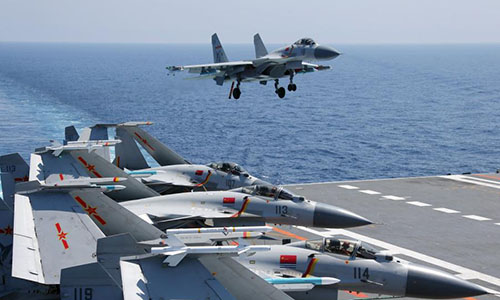Shenyang J-15
The Shenyang J-15 (Chinese: 歼-15), NATO reporting name: Flanker-X2, also known as Flying Shark (Chinese: 飞鲨; pinyin: Fēishā), is a Chinese all-weather, twinjet, carrier-based fourth-generation[3] multirole fighter aircraft developed by the Shenyang Aircraft Corporation (SAC) and the 601 Institute, specifically for the People's Liberation Army Naval Air Force (PLANAF) to serve on People's Liberation Army Navy's aircraft carriers.
An unfinished prototype Su-33, the T-10K-3, was acquired by SAC from Ukraine in 2001 and was said to have been studied extensively and reverse-engineered, with development on the J-15 beginning immediately afterward. While the J-15 appears to be structurally based on the prototype of Su-33, the fighter features indigenous Chinese technologies as well as avionics from the Shenyang J-11B program. In February 2018, discussions about replacing the aircraft appeared in several Chinese media outlets including Xinhua and China's main military newspaper, discussing that it belongs to the 4th- or 4.5-generation fighters. Thus, the J-15 is viewed as an interim carrier-based fighter until a fifth-generation successor enters service, one that may be based on the Chengdu J-20 or Shenyang FC-31.
An article in the China SignPost believes the J-15 "likely exceeds or matches the aerodynamic capabilities of virtually any fighter aircraft currently operated by regional militaries, with the exception of the U.S. F-22 Raptor", alleging that the J-15 likely possesses a 10% greater thrust-to-weight ratio and 25% lower wing loading than the F/A-18E/F Super Hornet. However, one of the authors of that same article described the J-15 in another article as no game changer; the reliance on ski-jump launches and lack of Chinese carrier-based aerial refueling capabilities are believed to greatly reduce its effective combat range. In 2014, it was revealed that the J-15 is capable of aerial refueling, using the UPAZ-1 buddy refueling pod, which can be carried by another J-15. Hu Siyuan of the PLA National Defense University said that "the current weak point of the J-15 is its Russian-made Al-31 engines, which are less powerful than that of the American F-35 fighter".
The J-15's chief designer, Sun Cong of the National Committee of the Chinese People's Political Consultative Conference, has said that the J-15 could match the F/A-18 in bomb load, combat radius and mobility. However, in a similar statement, he said more work was required on its electronics and combat systems. Rear Admiral Yin Zhuo stated that the aircraft's air combat capabilities were better than that of the F/A-18E/F Super Hornet. However, he also stated that its ability to attack land and sea targets was slightly inferior to the F/A-18E/F; it is also stated that its electronic equipment meets the standards of those on a fifth-generation fighter.
General characteristics
- Crew: 1 or 2
- Length: 22.28 m (73 ft 1 in)
- Wingspan: 15.0 m (49 ft 3 in)
- Width: 7.4 m (24 ft 3 in) wings folded
- Height: 5.92 m (19 ft 5 in)
- Wing area: 67.84 m2 (730.2 sq ft)
- Empty weight: 17,500 kg (38,581 lb)
- Gross weight: 27,000 kg (59,525 lb)
- Max takeoff weight: 32,500 kg (71,650 lb)
- Powerplant: 2 × Saturn AL-31[49] afterburning turbofans, 122.6 kN (27,600 lbf) thrust each
Performance
- Maximum speed: Mach 2.4
- Ferry range: 3,500 km (2,200 mi, 1,900 nmi)
- Service ceiling: 20,000 m (66,000 ft)
- Thrust/weight: 0.93
Armament
- 1 × 30 mm GSh-30-1 cannon with 150 rounds
- Munitions on twelve external hardpoints, including:
Avionics
- Type 1493 radar[50]
- MIL-STD-1553B bi-directional data bus
- glass cockpit
- LCD screen
- 4-redundant 3-axis fly by wire
Copied by wikipedia.

Comments
Post a Comment